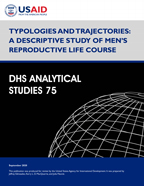There is no printed copy available to order.
Abstract:
There is little research on the implications of family formation patterns for individual outcomes and life course trajectories of men. This study uses the conceptual framework of life course theory to examine patterns of family formation for men age 30-34 in eight countries (Benin, Mali, Nigeria, Ethiopia, Rwanda, Uganda, India, and Nepal) and explore how these may influence economic, social, and fertility-related outcomes later in life. We examine three key research questions: (1) What are the patterns of key family formation events for men and how do these compare across countries; (2) What are trajectories of men’s family formation events, specifically from sex-to-marriage-to-birth, and how are patterns of timing for each of these events related to each other; and (3) What are the consequences of experiencing particular family formation trajectories? The analyses in this study are primarily descriptive, focusing on three key family formation events: first sex, first marriage, and birth of first child. We first calculate the median ages at each event for men age 30-34 for each country both at the national level and for rural and urban areas. We then use the median age as a marker of what represents the ‘typical’ age at which these events take place to categorize men into three groups based on the relative timing of each event: earlier-than-typical, at typical timing, and later-than-typical. Based on this, we develop specific trajectories for the family formation process and compare these across countries using Sankey diagrams. Finally, we examine the association of selected first marriage-to-birth of first child trajectories with key economic, social and fertility-related outcomes.
The results show that while there are important differences between the countries in their family formation patterns, mainly around the timing of events and the prevalence of premarital sexual activity and childbearing, three typologies of family formation are clearly identified. These broadly apply to both urban and rural areas, suggesting common drivers for family formation that are generally regionally based. The Sankey diagrams illustrate that there is considerable diversity in family formation in each country, but that the most common involves trajectories that were entirely or mostly typical in timing, with considerable continuity of timing between events.
In all settings, the patterns suggest that marriage or long-term cohabitation is a particularly significant family formation milestone, along with childbearing, especially in countries where premarital sexual activity is less common. The analysis of the relationship between first-marriage-to-birth of first child trajectories suggests that nontypically timed trajectories, particularly those that are earlier-than-typical, are associated with poorer outcomes for men.
These results suggest that life course theory is well suited to the exploration of family formation patterns for men and provides strong foundation for further analyses. They also suggest that, as is the case for women, men’s lives are shaped in important ways by their family formation experiences. More research is needed that focuses on better understanding the full implications of different life course trajectories for men’s lives, which will allow for the development of more effective program and policy interventions.
